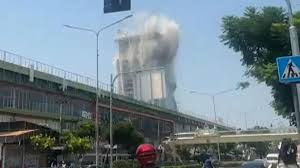On March 28, 2025, a powerful 7.7-magnitude earthquake struck central Myanmar, causing widespread destruction and panic across the region. The tremors were felt as far as Bangkok, Thailand, where significant damage occurred, including the collapse of a high-rise building under construction.
.jpg)
The Earthquake's Impact in Myanmar
The earthquake's epicenter was near Mandalay, Myanmar's second-largest city with a population of approximately 1.5 million. The shallow depth of the quake, about 10 kilometers, intensified its destructive potential. In Mandalay, multiple buildings collapsed, leaving streets strewn with debris and causing residents to flee their homes in fear. The historic Ava Bridge in Sagaing, a vital transportation link, suffered severe damage, disrupting travel and commerce in the region. In the capital city, Naypyidaw, roads buckled, and ceilings partially collapsed, further highlighting the quake's extensive reach.
Tremors Felt in Thailand
The seismic waves extended into neighboring Thailand, where Bangkok experienced significant shaking. Buildings swayed, alarms were triggered, and residents evacuated into the streets, creating scenes of chaos and panic. A high-rise building under construction in the Chatuchak district of Bangkok collapsed, trapping 43 workers under the rubble. Emergency services launched a massive rescue operation to locate and save those trapped. The Thai government declared a state of emergency in Bangkok, with Prime Minister Paetongtarn Shinawatra cutting short an official visit to Phuket to address the crisis.
Casualties and Rescue Efforts
In Myanmar, at least 20 fatalities were reported, with many more injured. Rescue teams worked tirelessly to search for survivors amidst the debris, facing challenges due to damaged infrastructure and aftershocks. In Bangkok, the focus was on rescuing the 43 construction workers trapped in the collapsed building. The city's emergency services, along with volunteers, coordinated efforts to clear debris and provide medical assistance to the injured.
Historical Context and Tectonic Activity
Myanmar is situated in a seismically active region, primarily due to the presence of the Sagaing Fault, a major right-lateral transform fault that accommodates the relative motion between the Indian and Sunda plates. This fault runs through several major cities, including Yangon, Naypyidaw, and Mandalay, making them particularly vulnerable to seismic events. Historically, the Sagaing Fault has been the source of several significant earthquakes:
-
1839 Ava Earthquake: Estimated at a magnitude of 8.0 or greater, this quake caused widespread destruction and loss of life.
-
1930 Bago Earthquake: With a magnitude of 7.3, this earthquake resulted in extensive damage in the Bago region.
-
1946 Sagaing Earthquakes: A series of quakes, including magnitudes of 7.3 and 7.7, impacted the Sagaing region, causing significant damage.
The recurrence of such powerful earthquakes underscores the seismic vulnerability of the region and the critical importance of preparedness and resilient infrastructure.
In the aftermath of the earthquake, both Myanmar and Thailand's governments mobilized resources to aid affected communities. In Myanmar, emergency services focused on search and rescue operations, providing medical care to the injured, and assessing the structural integrity of buildings. Temporary shelters were established for those displaced by the disaster.In Thailand, the declaration of a state of emergency facilitated the rapid deployment of resources to Bangkok. Rescue teams worked around the clock to locate and assist those trapped in the collapsed building. Public transportation services, including metro and light rail, experienced partial suspensions as safety inspections were conducted. Trading on the Stock Exchange of Thailand was also temporarily halted in response to the quake.
International Aid and Solidarity
The international community responded with offers of assistance and expressions of solidarity. Neighboring countries, humanitarian organizations, and international agencies coordinated efforts to provide aid, including financial support, medical supplies, and technical expertise in disaster response. The collaborative efforts highlighted the global commitment to supporting affected populations in times of crisis.
Lessons and Future Preparedness
This devastating earthquake serves as a stark reminder of the importance of earthquake preparedness, particularly in seismically active regions.
-
Infrastructure Resilience: Investing in earthquake-resistant construction and retrofitting existing structures can mitigate damage and save lives.
-
Early Warning Systems: Developing and implementing effective early warning systems can provide critical seconds or minutes for individuals to seek safety.
-
Community Education: Public awareness campaigns on earthquake safety measures can enhance individual and community preparedness.
-
Regional Cooperation: Collaborative efforts among neighboring countries can improve response times and resource sharing during disasters.
As the affected regions begin the arduous process of recovery and rebuilding, the emphasis on preparedness and resilience will be paramount in mitigating the impact of future seismic events.
https://visu00000.blogspot.com/




No comments:
Post a Comment